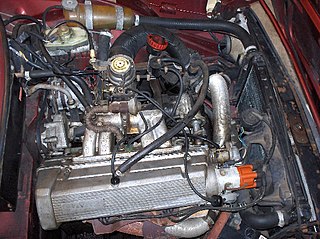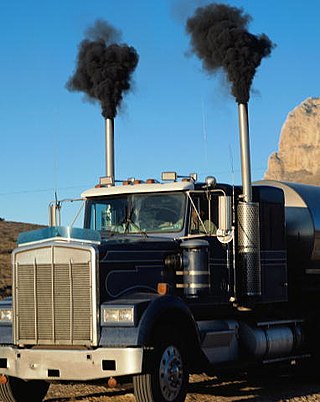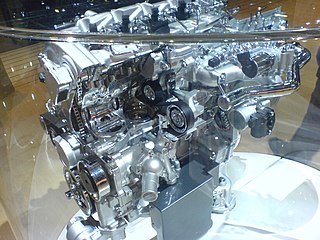Related Research Articles

In internal combustion engines, exhaust gas recirculation (EGR) is a nitrogen oxide (NOx) emissions reduction technique used in petrol/gasoline, diesel engines and some hydrogen engines. EGR works by recirculating a portion of an engine's exhaust gas back to the engine cylinders. The exhaust gas displaces atmospheric air and reduces O2 in the combustion chamber. Reducing the amount of oxygen reduces the amount of fuel that can burn in the cylinder thereby reducing peak in-cylinder temperatures. The actual amount of recirculated exhaust gas varies with the engine operating parameters.

A catalytic converter is an exhaust emission control device which converts toxic gases and pollutants in exhaust gas from an internal combustion engine into less-toxic pollutants by catalyzing a redox reaction. Catalytic converters are usually used with internal combustion engines fueled by gasoline or diesel, including lean-burn engines, and sometimes on kerosene heaters and stoves.
Vehicle emissions control is the study of reducing the emissions produced by motor vehicles, especially internal combustion engines.

Exhaust gas or flue gas is emitted as a result of the combustion of fuels such as natural gas, gasoline (petrol), diesel fuel, fuel oil, biodiesel blends, or coal. According to the type of engine, it is discharged into the atmosphere through an exhaust pipe, flue gas stack, or propelling nozzle. It often disperses downwind in a pattern called an exhaust plume.

The Duramax V8 engine is a family of 6.6 liter diesel V8 engines produced by DMAX, a wholly owned subsidiary of General Motors in Moraine, Ohio. The Duramax block and heads are supplied from reliable vendors of General Motors. This engine was initially installed in 2001 Chevrolet and GMC trucks, and has since become an option in pickups, vans, and medium-duty trucks. In 2006, production at Moraine was reportedly limited to approximately 200,000 engines per year. On May 9, 2007, DMAX announced the production of the 1,000,000th Duramax V8 at its Moraine facility, followed by the 2,000,000th on March 24, 2017.

Mazda has a long history of building its own diesel engines, with the exception of a few units that were built under license.

Power Stroke, also known as Powerstroke or PowerStroke, is the name used by a family of diesel engines for trucks produced by Ford Motor Company and Navistar International for Ford products since 1994. Along with its use in the Ford F-Series, applications include the Ford E-Series, Ford Excursion, and Ford LCF commercial truck. The name was also used for a diesel engine used in South American production of the Ford Ranger.

Engine braking occurs when the retarding forces within an internal combustion engine are used to slow down a motor vehicle, as opposed to using additional external braking mechanisms such as friction brakes or magnetic brakes.
The Detroit Diesel Series 50 is an inline four-cylinder diesel engine, that was introduced in 1993 by Detroit Diesel. The Series 50 was developed from the existing block of its sister engine, the Series 60, which itself was initially designed by Detroit Diesel. The cylinder heads were cast by John Deere at one time.

Diesel exhaust is the gaseous exhaust produced by a diesel type of internal combustion engine, plus any contained particulates. Its composition may vary with the fuel type or rate of consumption, or speed of engine operation, and whether the engine is in an on-road vehicle, farm vehicle, locomotive, marine vessel, or stationary generator or other application.
Selective catalytic reduction (SCR) means of converting nitrogen oxides, also referred to as NO
x with the aid of a catalyst into diatomic nitrogen, and water. A reductant, typically anhydrous ammonia, aqueous ammonia, or a urea solution, is added to a stream of flue or exhaust gas and is reacted onto a catalyst. As the reaction drives toward completion, nitrogen, and carbon dioxide, in the case of urea use, are produced.

Diesel exhaust fluid is a liquid used to reduce the amount of air pollution created by a diesel engine. Specifically, DEF is an aqueous urea solution made with 32.5% urea and 67.5% deionized water. DEF is consumed in a selective catalytic reduction (SCR) that lowers the concentration of nitrogen oxides in the diesel exhaust emissions from a diesel engine.

A diesel particulate filter (DPF) is a device designed to remove diesel particulate matter or soot from the exhaust gas of a diesel engine.
BlueTEC is Mercedes-Benz Group's marketing name for engines equipped with advanced NOx reducing technology for vehicle emissions control in diesel-powered vehicles. The technology in BlueTec vehicles includes a selective catalytic reduction (SCR) system that uses diesel exhaust fluid, and a system of NOx adsorbers the automaker calls DeNOx, which uses an oxidizing catalytic converter and diesel particulate filter combined with other NOx reducing systems.
A NOx adsorber or NOx trap (also called Lean NOx trap, abbr. LNT) is a device that is used to reduce oxides of nitrogen (NO and NO2) emissions from a lean burn internal combustion engine by means of adsorption.
The N series is Honda's first automotive diesel engine, an inline-four for medium-sized vehicles. It uses common rail direct injection, which Honda brands as i-CTDi. The most notable feature is the aluminium block, which uses proprietary technology in the manufacturing process to provide light weight and high rigidity. Roller chains drive two overhead camshafts. A variable-geometry turbocharger and intercooler are used.

The Volkswagen Crafter, introduced in 2006, is the largest three- to five-ton van produced and sold by the German automaker Volkswagen Commercial Vehicles. The Crafter officially replaced the Volkswagen Transporter LT that was launched in 1975, although it is known as the LT3, its production plant code.

The Toyota AD engine family is a series of 16 valve DOHC inline-4 turbo diesel engines with electronic common rail direct injection using an aluminium cylinder head and an aluminium cylinder block with cast iron liners derived from the petrol Toyota AZ engine. The AD engine is offered in 2.0 and 2.2 liter versions. These engines are produced mainly for Europe, but few are exported to other areas such as India or New Zealand.
Westport Innovations is a company that develops alternative fuel, low-emissions technologies to allow engines to operate on clean-burning fuels such as compressed natural gas (CNG), liquefied natural gas (LNG), hydrogen and biofuels such as landfill gas. Headquartered in Vancouver, British Columbia, Canada, where the company was founded, Westport also has facilities in France, Sweden, Italy, China, Australia and the United States.
References
- ↑ Inc, Cummins. "CUMMINS ANNOUNCES NEW X10 ENGINE, NEXT IN THE FUEL-AGNOSTIC SERIES, LAUNCHING IN NORTH AMERICA IN 2026". Cummins Newsroom. p. 1. Retrieved 26 March 2023.
{{cite news}}:|last=has generic name (help) - ↑ Inc, Cummins. "CUMMINS NEXT-GENERATION 2026 X10 ENGINE AND 2024 X15N NATURAL GAS COMPLETE POWERTRAIN EQUIPPED WITH THE LATEST DIGITAL TECHNOLOGIES ON DISPLAY FOR FIRST TIME AT TMC ANNUAL MEETING". Cummins Newsroom. p. 1. Retrieved 26 March 2023.
{{cite news}}:|last=has generic name (help) - ↑ McGlothlin, Mike (2023-02-21). "Cummins Launches New 10 Liter Diesel Engine". Diesel World. Retrieved 2023-07-02.
- ↑ "Cummins and Accelera showcase broadest portfolio of decarbonizing technologies with an emphasis on hydrogen". Cummins. 2023-05-03.
- ↑ "Cummins Inc. Debuts 15-Liter Hydrogen Engine at ACT Expo". Cummins. 2022-05-09.
- ↑ Xu, Shuonan (October 13, 2014). "Development of a Phenomenological Dual-Fuel Natural Gas Diesel Engine Simulation and Its Use for Analysis of Transient Operations". SAE International Journal of Engines. 7 (4): 1665–1673. doi:10.4271/2014-01-2546.
- ↑ Gerber, Raleigh (July 18, 2018). "Clean Energy Launches Zero Now Financing to Put Fleets in Clean New Natural Gas Trucks for the Price of a Diesel Truck". Business Wire. Retrieved February 20, 2019.
- ↑ McGeehan, A, J. (2012). "Extending the Boundaries of Diesel Particulate Filter Maintenance With Ultra-Low Ash". TRID. 5.
{{cite journal}}: CS1 maint: multiple names: authors list (link) - ↑ "Control of Emissions From New Highway Vehicles and Engines". EPA. June 7, 2011.
- ↑ Joshi, Y. V (2014). "Gear Train Mesh Efficiency Study: The Effects of an Anti-Backlash Gear". SAE International Journal of Commercial Vehicles. 7: 271–277. doi:10.4271/2014-01-1769.
- ↑ "History: Cummins engines Down Under". trucksales. May 28, 2019.
- ↑ "Cummins announces Gen II EGR engines". Cummins Commentary. March 28, 2012.